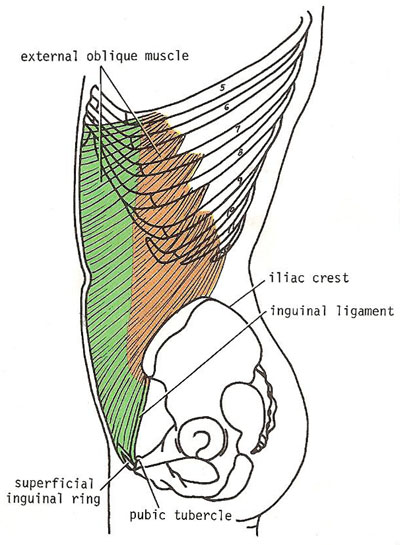external oblique muscle

Posterior aspect of cartilages and ligaments of the larynx.
The external oblique muscle is a broad, thin, muscular sheet that arises from the outer surfaces of the lower eight ribs and fans out to be inserted into the xiphoid process (the lowest part of the sternum or breastbone), the linea alba, the pubic crest, the pubic tubercle, and the anterior half of the iliac crest. The majority of the fibers are inserted by means of a broad aponeurosis. The most posterior fibers passing down to the iliac crest form a posterior free border.
A triangular-shaped defect in the external oblique aponeurosis lies immediately above and medial to the pubic tubercle. This is known as the superficial inguinal ring. The spermatic cord (or round ligament of the uterus) passes through this opening and carries the external spermatic fascia (or the external covering of the round ligament of the uterus) from the margins of the ring.
Between the anterior superior iliac spine and the pubic tubercle, the lower border of the aponeurosis is folded backward on itself, forming the inguinal ligament. From the medial end of the ligament the lacunar ligament extends backward and upward to the pectineal line on the superior ramus of the pubis. Its sharp, free crescentic edge forms the medial margin of the femoral ring. On reaching the pectineal line, the lacunar ligament becomes continuous with a thickening of the periosteum called the pectineal ligament.
The lateral part of the posterior edge of the inguinal ligament gives origin to part of the internal oblique and transverse abdominis muscles. To the inferior rounded border of the inguinal ligament is attached the deep fascia of the thigh, the fascia lata.


